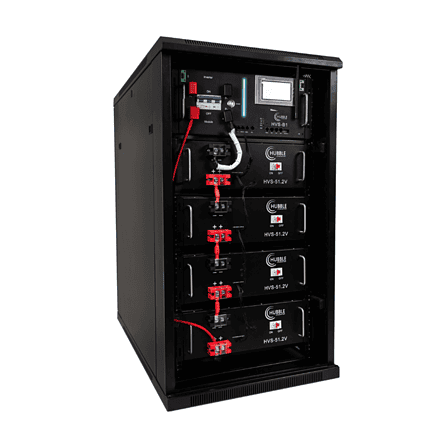

Rentech 51.2V 150Ah Lithium-Ion Battery – (7.68kWh)
R34,430.00 (incl. VAT)
IN STOCK WITH SUPPLIER – DISPATCHED WITHIN 3 WORKING DAYS
The Rentech 51.2V 150Ah Lithium-Ion Battery – (7.68kWh) is perfect in many applications, such as Motorhomes, Travel Trailers, Boats, yachts, Sailing, Trolling Motors, Electronics, Solar Back-Up power and other deep cycle applications.
It maintains consistent power and is equipped with a built-in overcharge protection.
This series combines safe and reliable LFP prismatic cells with dedicated BMS to guarantee high reliability safety and scalability. The product can be installed in a 19” or 21” standard cabinet rack.
Out of stock
Do you need assistance selecting the right product? Contact us today.
Neil: +27 72 690 2734
Rentech 51.2V Rack-Mounted Lithium-Ion Battery – 150Ah (7.68kWh) is designed for solar installations and back-up power in your Home and/or Office. This battery combines safe and reliable LFP prismatic cells with dedicated BMS to guarantee high reliability, safety and scalability.
The expected life cycle of the Rentech 51.2V Rack-Mounted Lithium-Ion Battery – 150Ah (7.68kWh) when installed, operated and maintained as per the manual is as follow:
- At <80% DOD, 6000 cycles
- At <90% DOD, 5000 cycles
It maintains consistent power and is equipped with a built-in overcharge protection.
Safety
- Automotive-grade pack technology and production process to guarantee safety
- Directional explosion-proof valve design to isolate rarely occurring cell failures, ensuring 100% safety
- Comprehensive thermal simulation and testing to control the temperature rise of each cell within the designed specification in the case of high-rate discharge
Battery Management System (BMS)
- Separate control and protection for the charge and discharge processess to maximise system availability
- Real time detection of voltage, current, temperature, SOH, SOC and a variety of protection
- Support for parallel connection
Cell
- LFP prismatic cells with high safety and reliability
- Fully automated production following a mature and stable process, ensuring consistent charge / discharge performance and life span
- IEC62133, UL and UN38.3 certifications
Communication and Protocol
- RS485 and RS232 interfaces
- Optional accessories
Rentech 51.2V 150Ah Lithium-Ion Battery Technical Sheet
Rentech 51.2V 150Ah Lithium-Ion Battery User Manual
Model: BTESF48V150-R
Voltage: 51.2V
Rated Capacity: 150Ah
Total Energy: 7.68 KWh
Recharge Voltage: 55,2V
Dimensions (mm): (d) 442 x (w) 52.5 (h) 13,05
Weight: 62,0kg
- SAFETY
- Over voltage protections system
- Low voltage protection system
- High temperature protection
- Low temperature protection
- Short circuit protection
- Over current protection
BATTERY MANAGEMENT SYSTEM (BMS)
- Separate control and protection for the charge and discharge processes to maximize system availability
- Real-time detection of voltage, current, temperature, SOH, SOC and a variety of protection
- Support for parallel connection only
CELL
- Lithium Iron Phosphate (LFP) prismatic cells with high safety and reliability
- Fully automated production following a mature and stable process, ensuring consistent charge / discharge performance and life span
- IEC62133, UL and UN38.3 certifications
BENEFITS OF SOLAR BATTERIES
- Source of clean energy
- Reduced noise levels compared to generators
- Cost savings
- Uninterrupted electricity supply
CONSIDERATIONS WHEN CHOOSING SOLAR BATTERIES
Capacity and power ratings
- A battery’s capacity is the total amount of energy it can store, measured in kilowatt-hours (kWh). The power rating is the amount of electricity that a battery can deliver at one time, measured in kilowatts (kW). A battery with high capacity and low power rating will deliver a low amount of electricity for a long time. A battery with a low capacity and high-power rating can run an entire home or larger operation, but only for a few hours.
Depth of Discharge
- Most solar batteries need to retail some charge at all time due to their chemical composition and to prolong their lifespan. The DoD refers to the maximum of a battery’s capacity that should be used. For example, sealed lead-acid solar batteries are usually operated at £ 50% DOD to achieve a reasonable cycle life, while lithium-ion batteries can operate at 80% DOD, 8kWh from a 10kWh battery, and still provide 5 years or more cycle life.
Round-trip efficiency
- Round-trip efficiency represents the amount of energy that can be used as a percentage of the amount of energy required to fully charge a battery. For example, if a 5kWh capacity battery, which delivers 4 kWh electricity, would typically require 110% to 120% times the 4kWh to be fully recharged. The battery has 80% to 90% in round-trip efficiency. One should, however, remember that the battery is part of the total system, and the system also has inefficiencies and energy losses.
Battery life and warranty
A battery’s ability to hold a charge gradually decreases the more it is used. For example, a battery might be warrantied for 5000 cycles or 10 years at 70% of its original capacity. This means that at the end of the warranty, the battery will have lost no more than 30% of its original ability to store energy.
Solar batteries come with warranties that guarantee a certain number of cycles and/or years of useful life.
This product has a 5-year warranty with a 10-year warranty option (refer to Rentech Lithium Warranty form)
| Weight | 61 kg |
|---|---|
| Dimensions | 43 × 43 × 17.7 cm |















